

Say you want to plant a tree. You wouldn’t do it on the first piece of land you come across, would you?
You’d do your research first—find fertile and well-drained soil and prospect a location that ensures optimal sunlight. That’s the only way to ensure your planting efforts bear fruit. 🍎
Similarly, you wouldn’t build a product without researching what customer needs to target. Customer or product discovery exercises are essential if you want your product to bear fruit, i.e., provide value to potential customers and achieve financial and market success.
As a product manager, how you approach your customer discovery interviews can steer you toward the right business decisions. You must ask the right questions to extract information crucial enough for shaping your product.
In this article, we’ll share our go-to customer discovery questions to help create new products or modify existing solutions. You’ll also find tips and tools to help make your discovery process effective and efficient.
What Are Customer Discovery Questions?
Customer discovery questions are questions you ask customers or clients to discover and understand their needs—particularly those that haven’t been met yet. Each unmet need is referred to as a pain point.
The pain points help product teams verify their assumptions about the market, estimate the profile of early adopters of the product, and focus on when developing something that’s both useful and well-received. 💗
Customer Discovery: Concept and Process
Customer discovery is the process of getting to know your target customers so you can build a product that serves them best, drives engagement, and sells well.
Usually, the process starts with the creation of a user persona depicting a specific demographic group and their relevant functional and psychological needs. Then, you use discovery questions to collect information from actual buyers and refine the persona as you go. In most cases, the data is shared with developer teams working on the product.
The discovery process doesn’t stop with the product launch, though, as customer needs change over time. You have to use analytics tools to collect real-time insights into customer behavior and adapt the product accordingly to retain your customers.
Tip: Use free ClickUp templates to simplify your customer or produce discovery processes. From product strategy to user personal templates, you can find 1,000+ pre-structured documents with built-in data management features to fast-track your workflows.
For example, you can use the ClickUp Customer Contact Form Template to collect and organize responses from market research and surveys in one place.

Relation between customer and product discovery
Customer and product discovery are tightly knit concepts but have distinct aims.
While the point of customer discovery is to understand the unmet needs of your target demographic, product discovery is all about identifying the product that meets those needs. It also zooms in on the how—the methods you should use to develop or modify the product and keep it relevant.
Common customer discovery methods
You can gain customer insights in many ways:
- Directly from customers: Maintain a record of customers’ problems by:
- Conducting live customer interviews with individuals and focus groups
- Distributing feedback forms online to reach a wider audience
- Leveraging social listening to monitor online discussions on your product
- Via internal discovery: Ask for insights from your sales teams and customer support representatives who interact with customers daily
- Through product analytics: Many product management tools include features such as session recordings and heatmaps to help you visualize customer journeys, track usage patterns, and detect problem areas
- By analyzing competitors and industry trends: Find out what your main competitors and industry leaders are doing and why. Strive to provide the same (or more) value and devise ways to capitalize on their weaknesses
Expert Customer Discovery Questions to Ask
In the following four sections, we’ll suggest some expert-recommended questions you can ask potential customers (in person or online) to better understand their pain points. You can modify the questions to work for your specific product or demographic.
1. Questions related to the customer pain points, roles, and everyday tasks
Ask these open-ended questions to observe how your product can be useful to the customer:
- What is your current job and your essential tasks?: The answer to this critical question will guide the conception and development of your product. It reveals the context in which the product will be used most often
- What are your major pain points at the moment?: The current struggles of the customer show where existing products fall short. Your product should ideally resolve these specific issues
- What are the biggest challenges you encounter when trying to do your job?: Although similar to the previous one, this question can reveal problems that are not apparent right away, helping you create well-rounded solutions
2. Questions related to existing solutions
To understand the products you’re competing against, ask the following:
- What tools do you currently use to solve problems specific to your job?: With this question, you can identify your biggest competitors. Your goal is to either complement the existing tools or surpass them by providing a more optimal solution
- What do you dislike about the solutions you’ve tried?: The answer to this question will pinpoint your competitors’ shortcomings. You’ll know what mistakes to look out for and what opportunistic new features to pay attention to when designing your product
Tip: How do you build a superior product? Use the ClickUp Competitor Tracking Template to keep track of your competitors’ products, features, and pricing.
3. Questions related to the user’s perspective of your product
Once your product is ready for trial runs, use the questions below to gather initial feedback:
- How easy is this product to use?: Intuitiveness and accessibility are the first criteria users will judge. If your product isn’t user-friendly, more users will be discouraged from exploring it, regardless of the number or quality of its features
- Are there any new features you’d prefer this product to have?: This question reveals any features you may have missed or additional ones you should include
- If you could change anything about this product, what would that be?: Ask what features customers or a particular customer segment are looking to tweak, and note down the reason for the inconvenience
4. Questions for gaining other valuable insights
Leverage the following to get more detailed feedback on your product:
- How likely are you to recommend this product to a coworker or friend?: This question enables you to quantify a user’s satisfaction levels
- Did you try any alternative solutions before this product?: Understand what sets your product apart from others and what made the user switch to it. It also reveals an average user’s criteria for evaluating products in that industry
- Are there any features that you don’t use?: While your product should be comprehensive, it should also be simple. If a feature doesn’t provide value, you should either revise it or remove it. Be careful, though. Sometimes, the root cause of the problem is not the feature itself but rather its adoption. In that case, just provide more assistance to new product users
- Is there anything that could make you stop using the product?: This question is valuable because it pinpoints red flags to look out for. It allows you to detect and address potential problems before they occur
When to Conduct Customer Discovery Interviews
Customer discovery questions should ideally be asked throughout the product development lifecycle. Since the market is dynamic and many unforeseen variables can affect customer preferences, it’s crucial to assess their opinions continuously and initiate product improvement efforts.
In the pre-launch stage, hypothesize about your target customers’ needs—the customer discovery interview questions we discussed before serve to test your hypotheses.
Once you know what to focus on when designing your product, move on to prototyping. Request customer opinion again when you create an early version of the product. This process allows you to understand whether the product solves their problems as well as looks and feels right.
After the launch, the aim of these questions is to provide guidelines for product optimization and customer success. You can:
- Fine-tune the features and the user experience
- Address current pain points you may have missed before
- Tackle usage challenges that came up in the meantime
Proper customer discovery will also facilitate your segmentation process. You’ll be able to understand lucrative user segments to implement a custom pricing strategy or provide more personalized experiences.
If you design and optimize your product with the customers in mind, you’ll ensure continuous product-market fit and customer satisfaction. You’ll also set the stage for effective product marketing and get that word-of-mouth going. 🗣️
Tools for Conducting Customer Discovery
You can make the collection and analysis of customer data more efficient with the right tools, such as:
Communication and video conferencing tools
These tools allow you to get in touch with customers, schedule interviews, and conduct them. Although in-person conversations are preferred for customer interviews, they aren’t always possible, so video conferencing is the next best thing. 📹
Surveys, forms, and questionnaires
If you need to collect large volumes of customer data, you can do so online via survey and questionnaire tools or distribute your questionnaire sheets at industry events.
Social media listening tools
Social media listening tools allow you to monitor social media channels for mentions of your product or company, gauge public perception, and respond to any praises and concerns quickly.
Bonus: Use ClickUp’s social media templates to streamline your online campaigns. Marketing teams of brands with heavy social media presence will love the ClickUp Social Media Strategy Workflow Template to schedule content and analyze performance metrics.
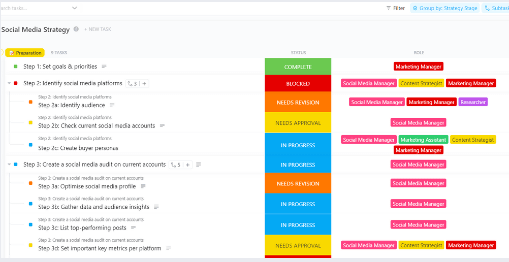
Customer relationship management (CRM) tools
CRM software serves as a hub where you can store and manage all the customer data you’ve gathered, including:
- Contact information
- Purchase history
- User feedback
- Complaints
Product and project management tools
Customer discovery is a complex and collective effort. Coordinate all the tasks involved across product and marketing teams using project management software. Such tools help streamline your discovery workflow, keep you on schedule, and help you track progress.
ClickUp: One Tool to Replace Them All
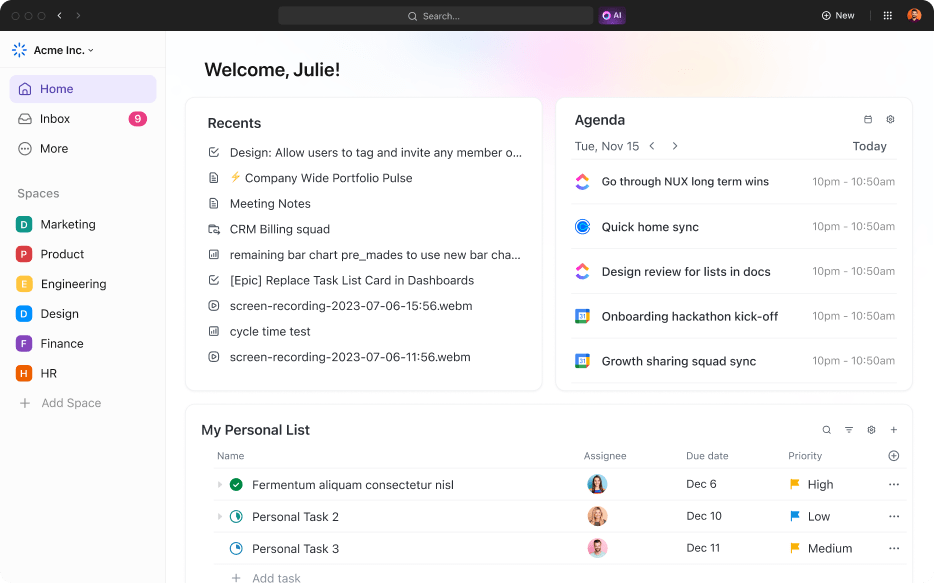
Instead of switching between all these apps and tools, why not use ClickUp? It’s a free and versatile work solution for project and product managers alike!
ClickUp can assist with product management and customer discovery throughout the product lifecycle—from the initial ideation stage to beyond the launch. 🌸
Use ClickUp Tasks to plan and coordinate work across research and marketing departments. ClickUp also offers several built-in communication tools, such as the Chat view and @mentions, to foster a clear understanding of team workflows.
You can choose between 15+ views to customize your Workspace. For example, use the Board view to plan your discovery efforts across product stages or use the Calendar view to schedule 1-1 customer interviews.
With ClickUp Forms, you can build tailored customer feedback surveys and distribute them across channels in a few clicks. If you don’t want to start from scratch, use one of ClickUp’s numerous questionnaire templates to get started. ClickUp can automatically turn responses into tasks—monitor them in the Table view and keep tabs on in-demand features or common user issues.
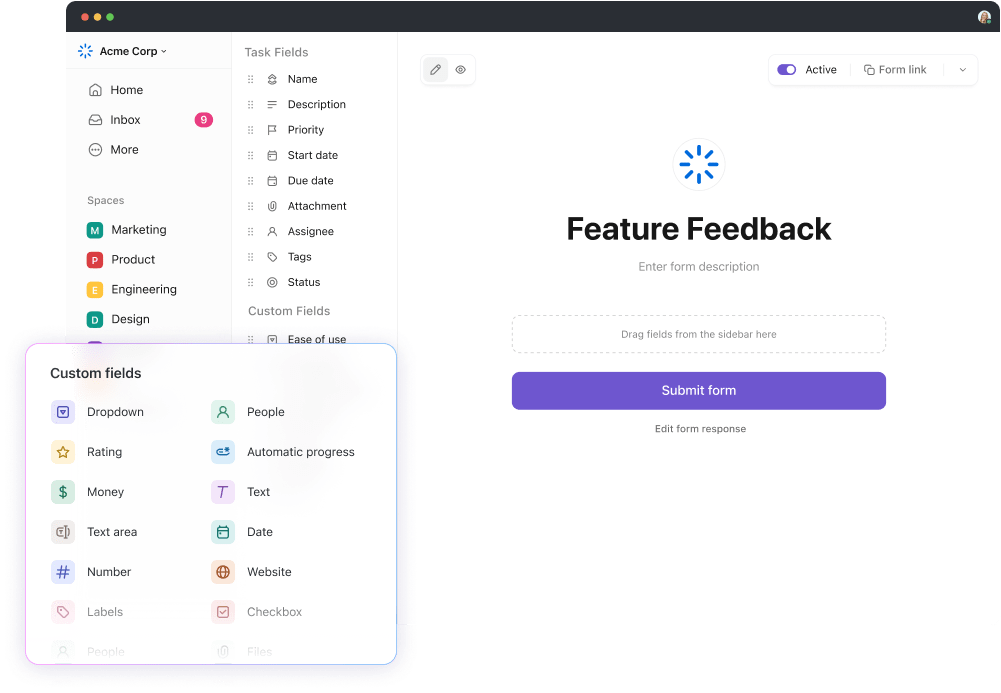
ClickUp CRM to stay aligned with customer satisfaction goals
ClickUp’s CRM Suite helps you manage customer information, sales pipelines, and orders and maintain stronger client relationships.
For starters, you can organize all your customer data and product strategies with ClickUp Docs. Create and refine customer personas promptly thanks to the platform’s AI assistant—ClickUp Brain. Leverage ready-made prompts to ask the tool to generate:
- Ideal user personas
- Research studies
- User stories
- Product discovery questions
- Content briefs
You can also brainstorm with the tool and generate product optimization ideas! 💡

Need to visualize user journeys with your team? ClickUp Whiteboards enable you to map out customer journeys on an easy-to-use, drag-and-drop canvas. Use the feature with your team leads to identify bottlenecks and strategize improvements proactively.
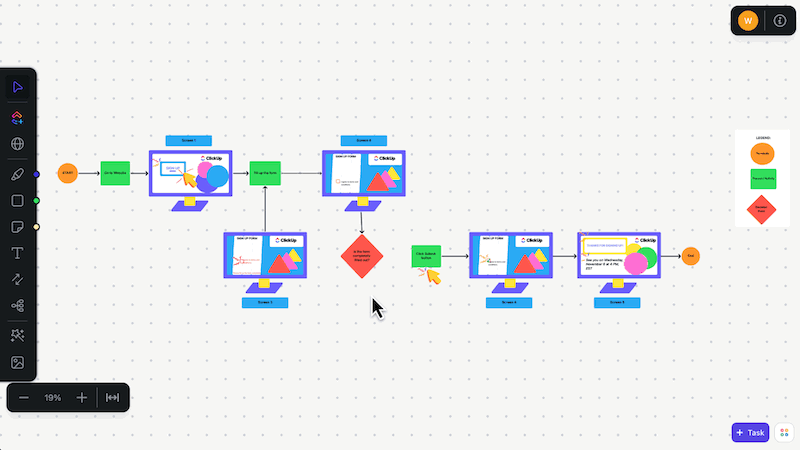
You can also set product launch goals and track them on a custom ClickUp Dashboard—use 50+ cards to view all customer and product metrics at a glance.
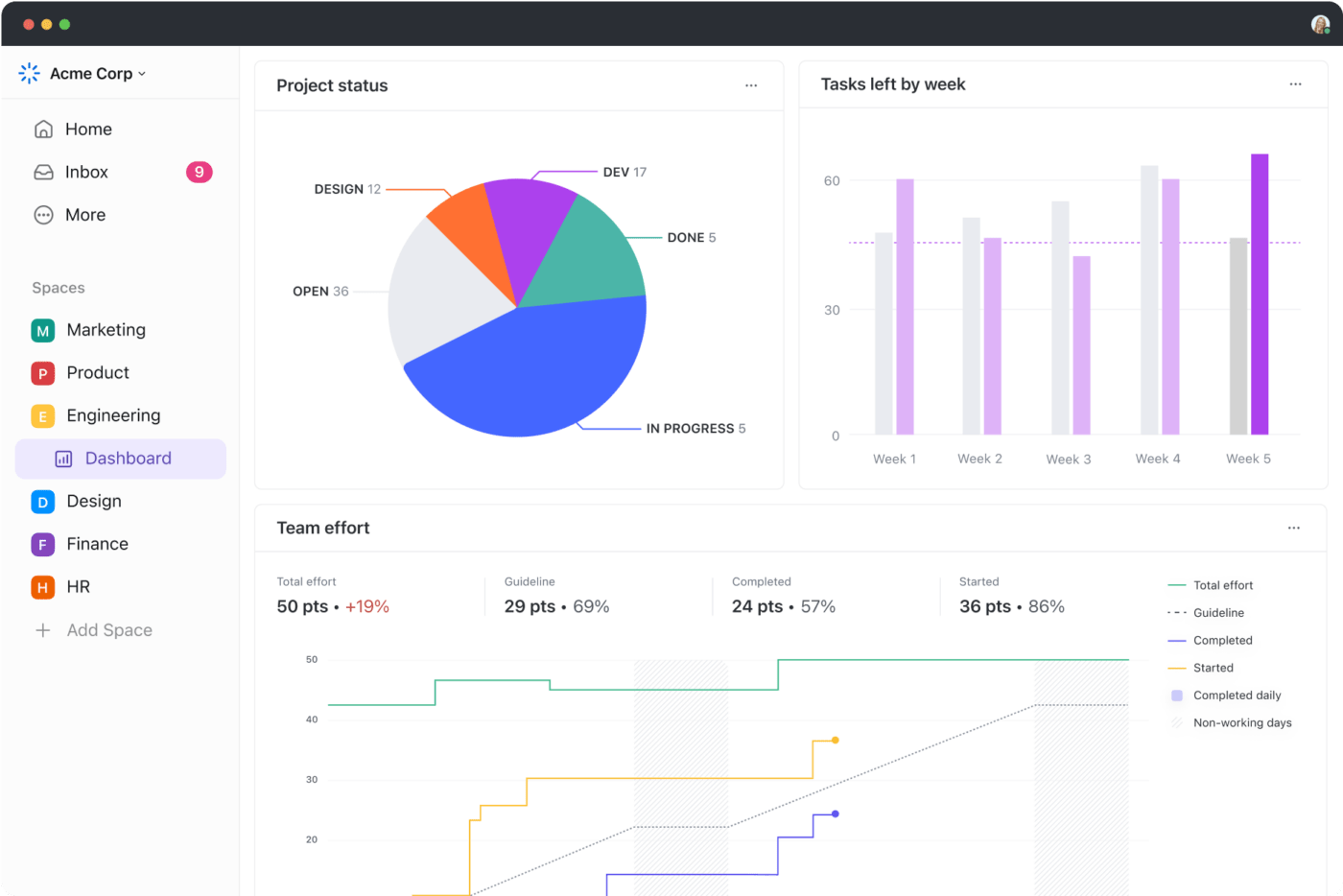
The best part about ClickUp is that it integrates with 1,000+ tools, including email providers and meeting software, ensuring all your apps are accessible from one place.
Do’s and Don’ts of Customer Discovery
Follow the tips below to make the most of your customer discovery efforts.
DO: Prepare and document everything
Have a clear goal in mind when reaching out to customers to learn as much as possible about them. Craft the question list carefully and stick to it to avoid wasting their time. ⌚
During the conversation, jot down all relevant observations. Organize the knowledge meticulously so you can access it easily later on.
DO: Make it a friendly conversation
Be amicable when interviewing customers in person. Smile and break the initial tension with some small talk. Although you’re going into it with a specific intention, the conversation cannot feel like an interrogation to the customer. That way, the potential customer will be more willing to open up and offer valuable insights. 🤝
DON’T: Be afraid of rejection
Hearing negative talk about your product idea hurts, but listen intently to the customer’s problems when they complain.
Think of it this way—if your assumptions were off, it’s better to hear the news in the early stages while you still haven’t invested a significant amount of time, money, and effort in the product’s development and marketing campaigns.
DON’T: Reveal too much during the conversation
Don’t overshare the intent of the interview. For example: Our product managers will use your responses to develop a new app.
Excessive information may make the customer feel burdened and uncomfortable, and they may refuse to share their honest thoughts.
Fast-Track Customer and Product Discovery with ClickUp
Customer discovery is a crucial step in building and optimizing products. When your decision-making is evidence-backed, your product and business are more likely to thrive. 🌟
With tools such as ClickUp, customer discovery can be not only fruitful but also streamlined. Get the free solution today and start unlocking customer insights in no time.



